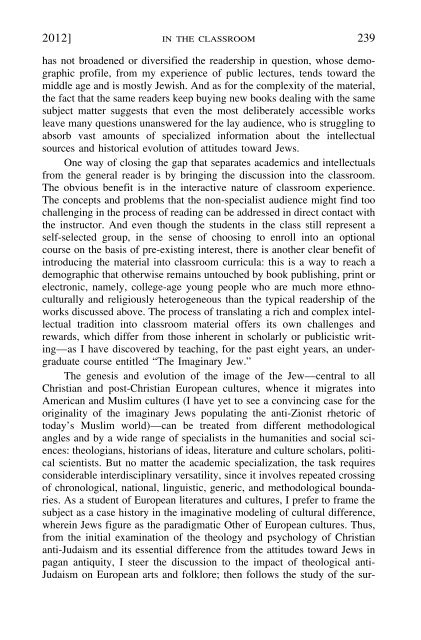Volume 4 No 1 - Journal for the Study of Antisemitism
Volume 4 No 1 - Journal for the Study of Antisemitism
Volume 4 No 1 - Journal for the Study of Antisemitism
Create successful ePaper yourself
Turn your PDF publications into a flip-book with our unique Google optimized e-Paper software.
2012] IN THE CLASSROOM 239<br />
has not broadened or diversified <strong>the</strong> readership in question, whose demographic<br />
pr<strong>of</strong>ile, from my experience <strong>of</strong> public lectures, tends toward <strong>the</strong><br />
middle age and is mostly Jewish. And as <strong>for</strong> <strong>the</strong> complexity <strong>of</strong> <strong>the</strong> material,<br />
<strong>the</strong> fact that <strong>the</strong> same readers keep buying new books dealing with <strong>the</strong> same<br />
subject matter suggests that even <strong>the</strong> most deliberately accessible works<br />
leave many questions unanswered <strong>for</strong> <strong>the</strong> lay audience, who is struggling to<br />
absorb vast amounts <strong>of</strong> specialized in<strong>for</strong>mation about <strong>the</strong> intellectual<br />
sources and historical evolution <strong>of</strong> attitudes toward Jews.<br />
One way <strong>of</strong> closing <strong>the</strong> gap that separates academics and intellectuals<br />
from <strong>the</strong> general reader is by bringing <strong>the</strong> discussion into <strong>the</strong> classroom.<br />
The obvious benefit is in <strong>the</strong> interactive nature <strong>of</strong> classroom experience.<br />
The concepts and problems that <strong>the</strong> non-specialist audience might find too<br />
challenging in <strong>the</strong> process <strong>of</strong> reading can be addressed in direct contact with<br />
<strong>the</strong> instructor. And even though <strong>the</strong> students in <strong>the</strong> class still represent a<br />
self-selected group, in <strong>the</strong> sense <strong>of</strong> choosing to enroll into an optional<br />
course on <strong>the</strong> basis <strong>of</strong> pre-existing interest, <strong>the</strong>re is ano<strong>the</strong>r clear benefit <strong>of</strong><br />
introducing <strong>the</strong> material into classroom curricula: this is a way to reach a<br />
demographic that o<strong>the</strong>rwise remains untouched by book publishing, print or<br />
electronic, namely, college-age young people who are much more ethnoculturally<br />
and religiously heterogeneous than <strong>the</strong> typical readership <strong>of</strong> <strong>the</strong><br />
works discussed above. The process <strong>of</strong> translating a rich and complex intellectual<br />
tradition into classroom material <strong>of</strong>fers its own challenges and<br />
rewards, which differ from those inherent in scholarly or publicistic writing—as<br />
I have discovered by teaching, <strong>for</strong> <strong>the</strong> past eight years, an undergraduate<br />
course entitled “The Imaginary Jew.”<br />
The genesis and evolution <strong>of</strong> <strong>the</strong> image <strong>of</strong> <strong>the</strong> Jew—central to all<br />
Christian and post-Christian European cultures, whence it migrates into<br />
American and Muslim cultures (I have yet to see a convincing case <strong>for</strong> <strong>the</strong><br />
originality <strong>of</strong> <strong>the</strong> imaginary Jews populating <strong>the</strong> anti-Zionist rhetoric <strong>of</strong><br />
today’s Muslim world)—can be treated from different methodological<br />
angles and by a wide range <strong>of</strong> specialists in <strong>the</strong> humanities and social sciences:<br />
<strong>the</strong>ologians, historians <strong>of</strong> ideas, literature and culture scholars, political<br />
scientists. But no matter <strong>the</strong> academic specialization, <strong>the</strong> task requires<br />
considerable interdisciplinary versatility, since it involves repeated crossing<br />
<strong>of</strong> chronological, national, linguistic, generic, and methodological boundaries.<br />
As a student <strong>of</strong> European literatures and cultures, I prefer to frame <strong>the</strong><br />
subject as a case history in <strong>the</strong> imaginative modeling <strong>of</strong> cultural difference,<br />
wherein Jews figure as <strong>the</strong> paradigmatic O<strong>the</strong>r <strong>of</strong> European cultures. Thus,<br />
from <strong>the</strong> initial examination <strong>of</strong> <strong>the</strong> <strong>the</strong>ology and psychology <strong>of</strong> Christian<br />
anti-Judaism and its essential difference from <strong>the</strong> attitudes toward Jews in<br />
pagan antiquity, I steer <strong>the</strong> discussion to <strong>the</strong> impact <strong>of</strong> <strong>the</strong>ological anti-<br />
Judaism on European arts and folklore; <strong>the</strong>n follows <strong>the</strong> study <strong>of</strong> <strong>the</strong> sur-














